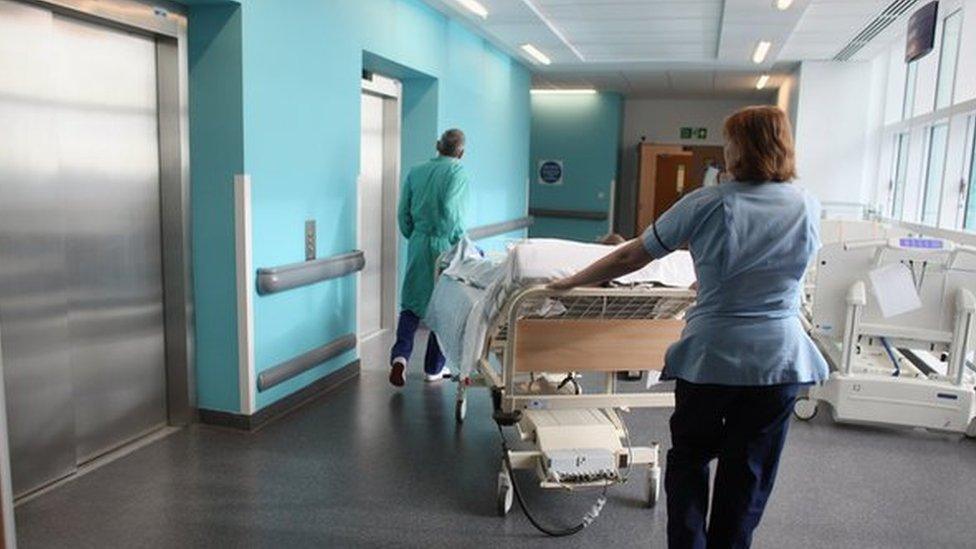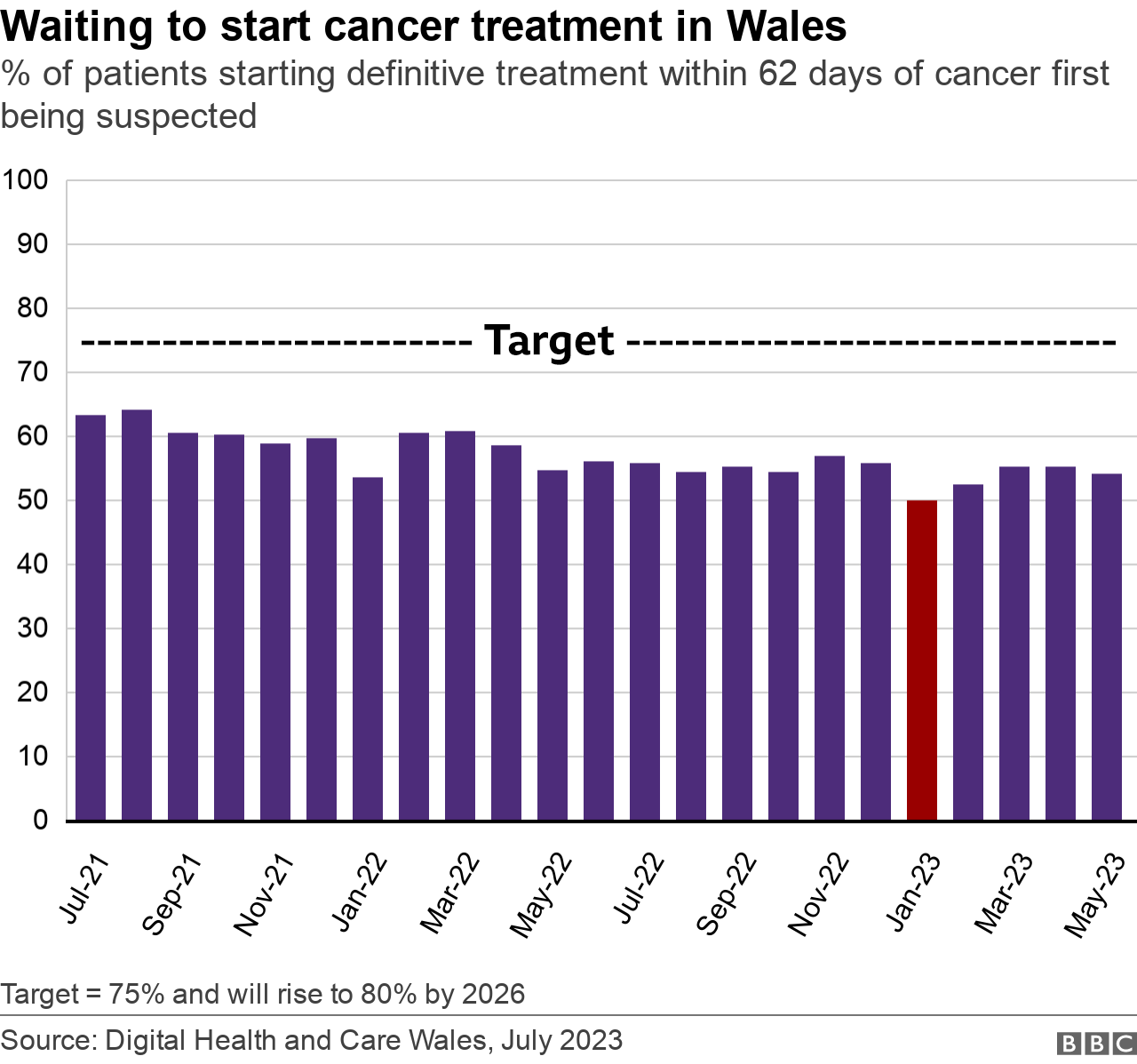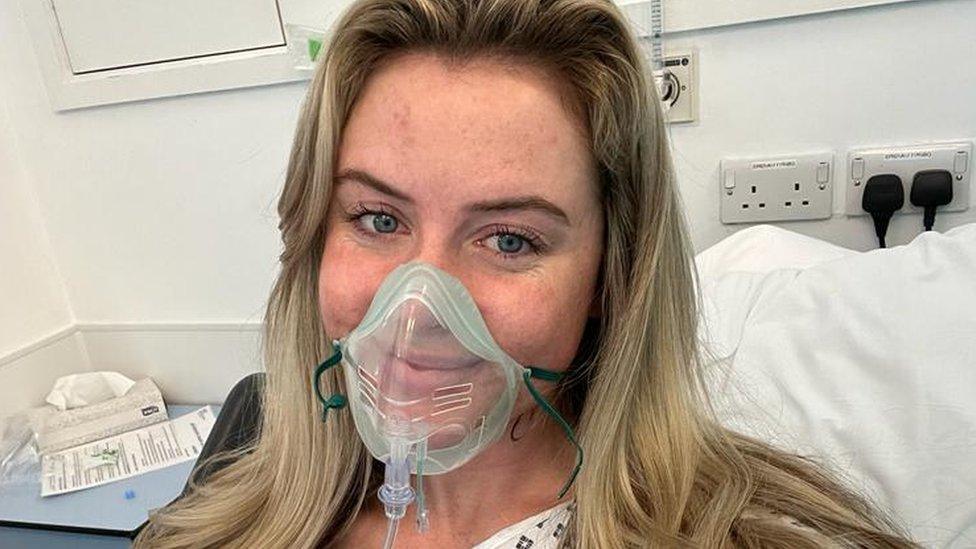NHS Wales waiting times: A&Es have record attendances
- Published

Health boards say services no longer fall into winter or summer pressures
Hospital waiting lists have risen again in Wales, although A&E waiting times improved despite record numbers turning up at emergency units.
Health boards said emergency departments had "little room to breathe" and services no longer fell into winter or summer pressures.
There were 748,395 "patient pathways" waiting for hospital treatment in May.
This is an extra 5,000 on the list, with 136,549 of these waits of more than a year.

There is also a target that no-one should wait more than two years - but 30,769 are still waiting that long.
Some patients are on more than one waiting list, so it it estimated that about 584,000 people are on waiting lists, a rise of 1,600 and a third successive increase after a fall in the previous five months.
The Welsh government said: "Although it is disappointing to see the overall numbers on the waiting list increased in May, the number of two-year waits fell for a 14th consecutive month and the average waiting time for treatment also decreased."
The spokesperson added that Health Minister Eluned Morgan "has set new targets for the health boards to tackle the longest waits and we will continue to support them in improving performance".

Waiting times for hospital treatment can be adjusted to make them more comparable with England.
This means that 20.1% of patients in Wales - in consultant-led specialisms - are waiting more than a year, compared to 5.2% of patients on similar waiting lists in England.
This proportion is slowly coming down in Wales.
There are 4.5% of patients in Wales waiting more than two years, compared to hardly any in England - 0.01%.
Welsh Conservatives said these two-year hospital waiting times were not falling fast enough and it could take another five years to eliminate the backlog at the current rate.
"This is a worrying trend and the Labour health minister needs to explain clearly to everyone waiting in pain for years, how exactly she is going to clear the backlog by April 2024," said Tory health spokesman Russell George.
How does this compare with parts of England?
The north east of England has been described as more comparable to Wales than looking at the whole of England. It has similar characteristics in terms of industrial heritage, its population make-up and sickness and poverty levels.
But the nine health trusts in the north east and Cumbria have been doing comparatively better than both the English and Welsh averages for the proportion of one year waits. Only around 2.4% of waiting lists there are made up of one-year waits, compared to 5.2% in England and 20.1% in Wales.
Within Wales, Cwm Taf Morgannwg health board has the highest proportion of one-year waits with 24% of those waiting for treatment for consultant-led specialisms.
There is no health trust in England which has a higher proportion of long waits than any of the health boards in Wales - the nearest being Manchester with 14% on the list waiting more than a year for treatment.

A key post-pandemic recovery target - that no-one should wait more than a year for an outpatient appointment - continues to be missed and has only reduced slightly over the past three months.
There were still 52,409 patients waiting more than a year for an outpatient appointment, a monthly drop of 422.
A&E's four-hour target to get people admitted, transferred or discharged was hit 72.5% of the time in June. The average waiting time stood at two hours and 37 minutes - a minute slower than the previous month but broadly back to pre-pandemic levels.
This came with 3,278 average daily attendances to emergency departments, the highest figure on record.
This was 78 attendances more per day on average than in May.
In all, 20% of people waited more than eight hours in emergency departments.
Darren Hughes, director of the Welsh NHS Confederation, which represents health boards, said: "This shows the incredible determination and hard work of staff in the face of adversity".
However he said without changes in improving public health and funding "we cannot expect these exceptional levels of demand to fall".

The Grange Hospital near Cwmbran (51.1%) and Glan Clwyd Hospital in Denbighshire (56.4%) had the worst performances against target, although The Grange does not deal with minor injury patients, which may affect its figures.
When we compare major A&E units in Wales with those of similar grade in England, then for the last 10 months, Welsh emergency departments have been performing better than those in England against the four-hour target.
Meanwhile, 8,526 people spent 12 hours or more in A&E, 457 fewer than the previous month.
The Royal College of Emergency Medicine said some patients waiting more than 12 hours were classed as "breach exemptions" and excluded from the data due to clinical and operational processes.
"We urge the Welsh government to ensure data is transparent and meaningful so that no patient is hidden," said Dr Suresh Pillai, RCEM vice president in Wales.
"To tackle the delays in emergency care, we must see the true scale of dangerously long delays and abolish these 12-hour breach exemptions".
Despite being well enough to be discharged, 1,625 patients remained in hospital. Most of these were elderly patients waiting for assessment, care places or support.

Ambulance response times improved again, with 54.6% of immediately life-threatening "red" calls attended to within eight minutes in June - the best performance since summer 2021, although still outside the target.
The average response time was seven minutes 16 seconds, nine seconds quicker than May and 39 seconds quicker than a year ago.
Ambulance handover delays fell again - although there were still nearly 18,274 "lost" hours.
This is time spent above 15 minutes, when ambulances wait to hand over patients at major emergency units.

Cancer waiting time performance was the worst for three months - with 54.1% of patients starting their first definitive treatment within 62 days of cancer first being suspected.
Simon Sheeres, of Cancer Research UK, said: "It is unacceptable that almost half of cancer patients in Wales are not being treated quickly enough.
"Behind today's numbers are patients who are anxious about their future and hard-working NHS staff who are stretched to capacity."
Plaid Cymru called on the Welsh government to outline a plan for tackling the most urgent cases.
Health spokesman Mabon ap Gwynfor said: "Five thousand more added to waiting lists, and only one in two cancer patients receiving their first treatment within target - this is a government that is continuing to fail to get to grips with the gridlock in our NHS."
Prof Jon Barry, Royal College of Surgeons director in Wales, said: "In the month that we have celebrated the NHS at 75, I am disappointed to see the waiting list continue to rise. These rises show the amount of work ahead of us to reduce the significant number of patients waiting for too long."
Related topics
- Published22 June 2023

- Published18 May 2023

- Published8 March 2023

- Published23 February 2023
